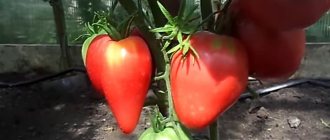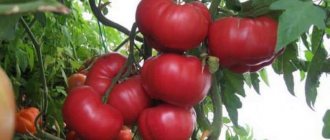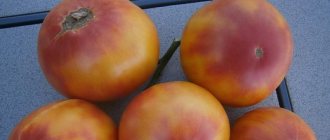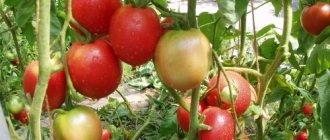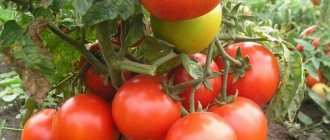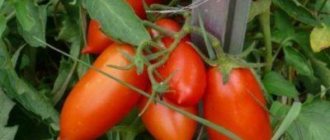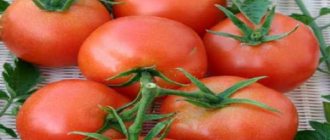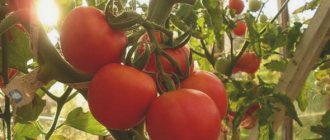» Vegetable growing » Tomatoes » Rules for growing tomato Khlebosolny
0
2269
Article rating
One of the best varieties bred by Siberian breeders is the Khlebosolny tomato. It tolerates sudden changes in weather well, has good yield and excellent taste.
- Advantages and disadvantages
- Growing seedlings
- Seed preparation
- Priming
- Capacity
- Sowing scheme
- Seedling care
- Transfer
- Site and soil
- Disembarkation scheme
- Care
- Watering
- Feeding
- Formation
- Ventilation
- Diseases and pests
- Common mistakes when growing
- Reviews from gardeners
Rules for growing Tomato Hospitable
Brief information about the variety
- Fruits and bush : at first the tomato is pink, after biological maturity it becomes bright red. The average weight is 300-600 g, but you can grow giant tomatoes weighing up to 1 kg. Determinate bush, height – 0.8-1 m.
- Productivity : from one bush – 4-5 kg of fruit.
- Resistance : good cold resistance and resistance to nightshade diseases.
- Distribution : suitable for cultivation in central Russia, the Urals and even in the north. Good yield indicators are noted when grown in the south.
- Application : for preparing first and second courses, salads, juice, ketchup, pasta and lecho. Large tomatoes are not suitable for whole canning. Many housewives roll them into jars in pieces.
- Planting : seedling method. The timing of sowing seeds is the second half of March, planting in a greenhouse is the first half of May, and in the garden bed is the last ten days of May. Planting pattern – 50×50 cm.
- Soil : light, loose, slightly acidic, fertilized with organic matter and mineral fertilizers.
- Care : fertilizing, watering, loosening, weeding and garter.
- Ripening period : fruiting occurs 100-110 days from the moment the first cotyledon leaves appear. In cool conditions, the fruits are stored for about 1.5 months.
Features of the fruit
As already mentioned, the Khlebosolny tomato is a large-fruited variety. These are everyone's favorite summer giants, which are distinguished by their excellent taste. The fruits are flat-round, slightly ribbed, bright red, fleshy and sweet. It is their tender flesh that makes them most suitable for preparing summer salads. If you don't like watery and sour fruits, then this is the best tomato for you. Hospitable (reviews fully confirm this name) tomatoes will become a real lifesaver in the summer heat, especially if guests suddenly come.
Characteristics of the variety
This is a mid-early variety of determinate type. Tomatoes have a marketable appearance and good taste.
Description of the bush
The description of the Khlebosolny tomato includes the following characteristics:
- plant height – 0.8-1 m;
- the aboveground part is spreading, with medium foliage;
- shoots and foliage are dark green;
- elongated leaf plate;
- About 10 fruits are formed on the brush;
- the plant does not require formation, but needs garter.
Description of fruits
Fruit characteristics:
- at first the fruit is pink, upon reaching full biological maturity it becomes bright red;
- the pulp is sugary and fleshy;
- average weight - 300-600 g, when rationing the ovaries you can get giant tomatoes weighing up to 1 kg;
- round, flattened shape;
- fruits are slightly ribbed;
- the taste is pleasant, sweet;
- the number of seeds is small.
Application area
The use of the Khlebosolny tomato variety is universal: it is used for preparing first and second courses, delicious salads, juice, ketchup, pasta and lecho. Large tomatoes are not suitable for canning in their entirety. Many housewives roll them into jars in pieces.
Productivity and fruiting
The productivity of this crop largely depends on its care. On average, 4-5 kg of fruits are harvested from one bush. Even in Siberia you can get a decent harvest of fruits.
Fruiting occurs 100-110 days from the moment the first cotyledon leaves appear.
Growing regions
The variety has no disadvantages
The cold-resistant tomato Khlebosolny is suitable for cultivation in the regions of central Russia, the Urals, and Siberia. Good yield indicators are noted when growing the variety in the south (in the Krasnodar region, Kuban, Astrakhan region).
Application
The Khlebosolny variety is a salad variety. Tomatoes are used for fresh consumption, for cutting and salads. They can also be added to various dishes that are subject to heat treatment. Allowed for use in dietary and baby food.
Due to their size, they are not suitable for whole-fruit canning. However, they can be processed into juice, paste or ketchup.
Watch the video! How to collect tomato seeds. Tomato variety Khlebosolny
Growing seedlings
Successful cultivation of Khlebosolnye tomatoes depends on high-quality seedlings. To prevent it from stretching out, it is important to observe the timing of sowing seeds - the second half of March. Before planting in a garden bed in open ground or in a greenhouse, the bushes will become stronger, grow up to 25 cm and form 3 pairs of leaves.
Seed preparation
The seed must be fresh, then you can achieve almost 100% germination. You can buy seeds at a gardening store or collect them from last summer's harvest.
Before sowing, they need to be processed - sorted by soaking in salt water (10 g per 1 liter). Poor quality seeds will float to the surface. Then, immerse in a concentrated solution of potassium permanganate for 30 minutes, rinse with clean water and spray with one of the growth stimulants (Epin, Zircon).
To make the seeds hatch faster, 2 days before sowing they are wrapped in damp cloth. Transfer the saucer with them to a cool, shaded place. To avoid drying out, the seeds should be periodically irrigated with water.
():
To help the seeds germinate faster, they should be kept warm and moist. The temperature for seed germination should be 3-4 degrees higher than the optimal temperature for crop growth. So, for a tomato, the optimal temperature for growth is 22-24 degrees. Therefore, for its seeds to germinate, a temperature of 25-27 degrees is required.
Priming
You can get strong seedlings if you use high-quality soil:
- Gardeners usually take store-bought soil to grow vegetable seedlings;
- others prepare it at home - mix humus, garden soil, sawdust (sand), wood ash in a ratio of 1:2:1:1.
Before placing it in a container, the soil is disinfected - calcined in the oven or poured with boiling water/raspberry solution of potassium permanganate. This manipulation helps to destroy all larvae and bacteria that cause disease in sprouts.
Capacity
You can sow seeds in seedling boxes or plastic containers. You can also use 400 ml disposable containers or plant them in peat pots. Several holes are made in the bottom of each container to drain excess moisture.
When sowing seeds in disposable containers, there is no need for picking, which means the risk of injury to the sprouts during planting is reduced.
():
Picking allows you to get better quality seedlings, because When transplanted into separate containers, seedlings are buried almost to the cotyledon leaves. This reduces the growth of elongated seedlings and increases the zone of root formation on the stem.
Sowing scheme
When sowing in groups, the seeds are placed in furrows according to a 3x5 cm pattern. If you are using disposable containers, 1-2 seeds will be needed per container. The seeding depth is 1-1.5 cm.
Seeds are prepared for planting
They are sprinkled with a thin layer of earth and sand mixed in equal parts. Then spray with settled water and cover with a transparent film.
Seedling care
The seedlings are placed in a warm place with diffused light and protection from the scorching sun during the midday hours. This is a light-loving crop, so it requires lighting at least 4 hours a day. The temperature in the mini-greenhouse should be 24-26 °C, humidity – 60%.
Before germination, the crops are regularly ventilated to avoid the appearance of condensation and, as a result, mold on the soil surface. They also need periodic irrigation with warm water as they dry out. All weed sprouts are removed, otherwise they will choke the young crops, which will lead to their death.
7-8 days after the mass emergence of seedlings, remove the shelter and lower the temperature to 15-17 °C for 5 days. This technique stimulates root growth and prevents sprouts from stretching. After this time, the Hospitable tomatoes are returned to the heat.
When sowing in groups, picking will be required at the stage of the appearance of the first true leaves. First, the tomatoes are watered abundantly, then, an hour after moistening, they are carefully removed and, together with a lump of earth, transplanted into separate pots. The lack of soil in the planting container is replenished with a nutrient mixture of humus and garden soil (1:1).
():
Picking is usually carried out 15-20 days after emergence.
Transfer
Before planting on the site, tender seedlings need to be hardened off. This will make it easier for her to take root in a new place and quickly grow. For 10 days, she is taken out into the fresh air and kept there for 2-3 hours. A day before transplantation, she is left overnight under cover on the street.
The optimal time for planting in the greenhouse is the first half of May, in the garden - the last ten days of May.
Site and soil
The hospitable tomato likes to grow in the sun, on moderately moist soil and in a windless place. The soil should be light, well-drained and low acidity.
The bed is prepared in the fall. Choose a place where cucumbers, cabbage, onions, garlic or legumes previously grew. Remove all weeds and remaining vegetation. Per 1 m², add 10 kg of leaf compost or rotted manure, 3-4 kg of wood ash, 100 g of superphosphate and 80 g of potassium salt. To deoxidize the soil, you need to add 300 g of slaked lime or chalk.
():
Large doses of ash (up to 3-4 kg per square meter) can only be applied on acidic soils. On neutral and slightly alkaline systems, the annual ash application rate should be no more than 250-300 g per square meter. Ash alkalizes the soil.
After this, deep digging is carried out. 2 weeks before the planned planting, the garden bed is watered with one of the following disinfectants:
- concentrated solution of potassium permanganate;
- urea solution - 1 tbsp. l. substances into a bucket of water.
Disembarkation scheme
Seedlings are planted according to a 50x50 cm pattern. The optimal number per 1 m² is 5-6 plants. Holes dug according to the size of the root system of the seedlings are watered with water - 0.5 liters each. A support about 1 m high is installed next to each hole. The roots are lowered into the holes, sprinkled with soil and hilled up.
In the first 3-4 days, it is necessary to create a shelter for tomatoes from the scorching sun from burlap or agrofibre. At night, plantings are covered with film to protect them from freezing.
():
White agrofibre serves both as protection from the scorching sun during the day and from low temperatures at night or during cold snaps.
Soil requirement
For tomatoes, you need to choose light, fertile soils; you can artificially supplement them with sand and forest humus. It is advisable to choose only organic fertilizers, these are wood ash and cow manure in the form of a 1:10 solution. In order for the plant to grow well and form additional roots, it is planted at an angle and then hilled well. The Khlebosolny tomato does not need to be planted, since the variety is medium-sized and quite compact.
Care
All subsequent care for Khlebosolny tomato variety consists of several procedures.
Watering
Plants are watered regularly. The first moistening is carried out a week after transplanting the seedlings to the site. Then the bed is moistened as the soil dries. Water is poured from a watering can or jar under the root to avoid moisture getting on the stems and leaves, otherwise they will get burned or rot.
The bushes need to be watered before flowering and at the stage of fruiting. Consumption per plant – 5-6 liters.
Watering is carried out strictly at the root
To avoid the formation of an earthen crust on the surface, after watering the soil is loosened and weeded between the rows. Mulching with garden soil or peat will protect the crop from drying out the soil and lodging of the stems.
Feeding
Throughout the entire season, Khlebosolnye tomatoes need to be fed several times. The first fertilizing with nitrogen-containing preparations (nitrophoska or urea - 15 g per bucket of water) is carried out 20 days after transplanting the seedlings to the garden bed. 0.5 liters are poured under each bush.
The next feeding is carried out before flowering and during the period of filling tomatoes with superphosphate and potassium sulfate (15 g per 10 liters of water). Consumption – 0.5 l per bush. Additionally, the culture is treated with a solution of boric acid (0.2 g per 1 liter of hot water). Spray twice - in the phase of budding and ovary development.
Formation
According to the description, this tomato variety does not require shaping. It is only necessary to remove unnecessary stepsons and leaves at the bottom of the crop, which take away all the useful substances from the bushes.
Ventilation
When growing Khlebosolny tomatoes in greenhouse conditions, regular ventilation is required, which will prevent the appearance of mold and condensation in the garden bed. The greenhouse is opened slightly in the first half of the day for 1-1.5 hours. On warm days, you can leave the door or windows open until sunset.
Reviews from gardeners
The Khlebosolny variety has become widespread among gardeners and gardeners. All reviews confirm the exceptional unpretentiousness and high productivity of this variety. The excellent taste of this vegetable is especially emphasized. Large, fleshy tomatoes are excellent in summer salads; they produce delicious juice, but they are not suitable for pickling. Gardeners note that plants begin to bear fruit quite early and provide fresh fruit throughout the summer.
Diseases and pests
Tomato Khlebosolny is resistant to late blight, fusarium wilt, and tobacco mosaic, which often affect greenhouse crops. But plants in protected soil are threatened by root, apical and white rot.
For prevention, seedlings and adult bushes are sprayed with Fitosporin or a weak solution of potassium permanganate before flowering.
In open ground, tomatoes are attacked by various parasites - aphids, spider mites, armyworms, and whiteflies. The first can be destroyed with an ash-soap solution or tobacco infusion. Insecticides (Aktellik, Aktara and Fundazol) help against ticks, whiteflies and cutworms.
Treatment is carried out 2-3 times with an interval of 7 days. In case of damage during the fruiting phase, the bushes are removed from the site, because Vegetables treated with chemicals are unsuitable for consumption.
Common mistakes when growing
Usually, difficulties in growing this crop arise due to non-compliance with the rules of agricultural technology, as a result of which the tomatoes become sick and produce a poor harvest.
The most common mistakes:
- sowing infected or expired seeds;
- using poor, heavy and acidified soil for growing seedlings;
- planting too deep, as a result of which the seedlings lag behind in development or do not germinate at all;
- planting on a bed without hardening, which leads to sunburn and frequent freezing of seedlings;
- non-compliance with the irrigation regime, planting scheme and dosage rates when applying fertilizers;
- lack of weeding, loosening;
- violation of crop rotation rules and thickening of plantings, as a result of which tomatoes begin to get sick, bloom poorly and produce a poor harvest.
Tomato “Hospitable”
Review of tomatoes 2017 (firewood, salty, Irish, orange strawberry, heavenly delight, heart of Ashgab)
THE VERY FIRST TOMATOES! VARIETY BARELY PINK. Olga Chernova.
Watering rules
Khlebosolny is an excellent variety; tomatoes are undemanding to watering, but this does not mean that they do not need to be watered at all. Moisten the soil under them only when it is clearly drying out. Water early in the morning or late in the evening. You should not water tomatoes during the day, as this leads to the appearance of perspiration inside the bushes, which contributes to the occurrence of fungal diseases.
Brazil nuts - benefits and harms, beneficial properties for women and men
In general, the Hospitable pink tomato and other varieties of the variety are not subject to any diseases with proper care. As for pests, they, of course, can appear. You need to get rid of them on time and it is advisable to use environmentally friendly control measures. Vegetable growers use insecticides only against spider mites.
Tomatoes of the Khlebosolny variety are fed no more than three times per season with an interval of 14 to 20 days.
To avoid the appearance of harmful insects on the bushes, it is advisable to treat them with a weak solution of potassium permanganate; it is even better to use phytosporin. This can be done in the early morning or late evening, but not in foggy weather.
On a note! You can provide yourself with the seeds of these wonderful tomatoes.
Olga Danilina
